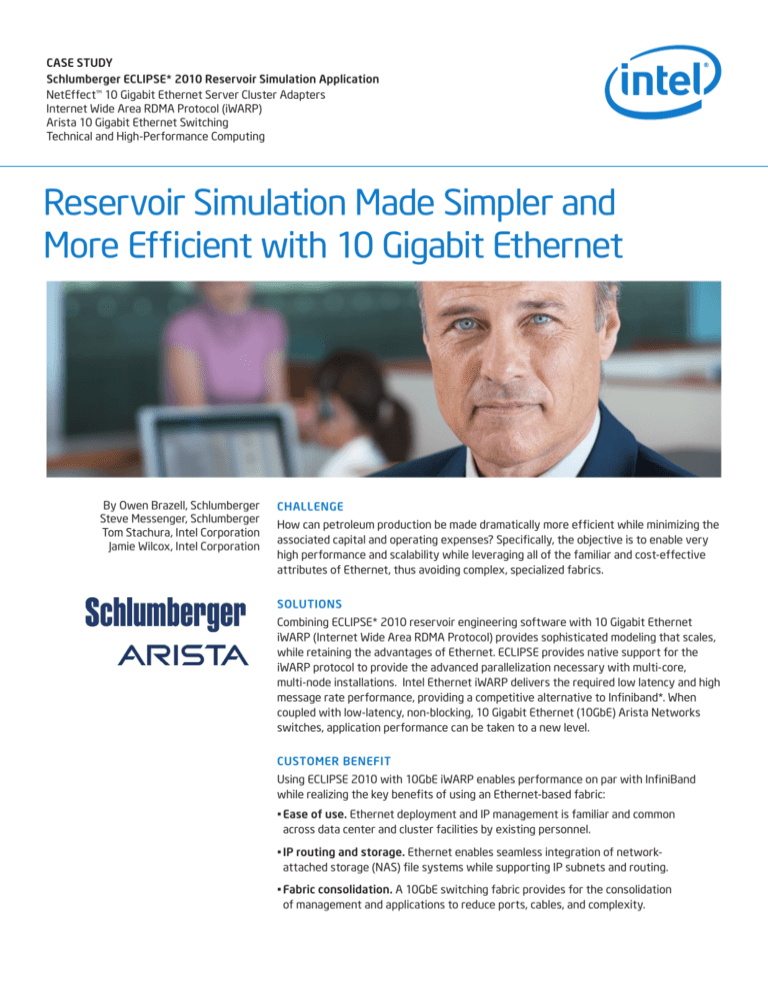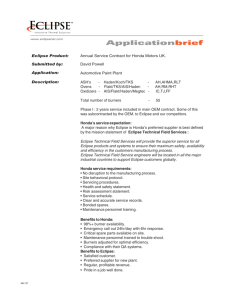
case study
Schlumberger ECLIPSE* 2010 Reservoir Simulation Application
NetEffect™ 10 Gigabit Ethernet Server Cluster Adapters
Internet Wide Area RDMA Protocol (iWARP)
Arista 10 Gigabit Ethernet Switching
Technical and High-Performance Computing
Reservoir Simulation Made Simpler and
More Efficient with 10 Gigabit Ethernet
By Owen Brazell, Schlumberger
Steve Messenger, Schlumberger
Tom Stachura, Intel Corporation
Jamie Wilcox, Intel Corporation
Challenge
How can petroleum production be made dramatically more efficient while minimizing the
associated capital and operating expenses? Specifically, the objective is to enable very
high performance and scalability while leveraging all of the familiar and cost-effective
attributes of Ethernet, thus avoiding complex, specialized fabrics.
Solutions
Combining ECLIPSE* 2010 reservoir engineering software with 10 Gigabit Ethernet
iWARP (Internet Wide Area RDMA Protocol) provides sophisticated modeling that scales,
while retaining the advantages of Ethernet. ECLIPSE provides native support for the
iWARP protocol to provide the advanced parallelization necessary with multi-core,
multi-node installations. Intel Ethernet iWARP delivers the required low latency and high
message rate performance, providing a competitive alternative to Infiniband*. When
coupled with low-latency, non-blocking, 10 Gigabit Ethernet (10GbE) Arista Networks
switches, application performance can be taken to a new level.
Customer Benefit
Using ECLIPSE 2010 with 10GbE iWARP enables performance on par with InfiniBand
while realizing the key benefits of using an Ethernet-based fabric:
•Ease of use. Ethernet deployment and IP management is familiar and common
across data center and cluster facilities by existing personnel.
•IP routing and storage. Ethernet enables seamless integration of networkattached storage (NAS) file systems while supporting IP subnets and routing.
•Fabric consolidation. A 10GbE switching fabric provides for the consolidation
of management and applications to reduce ports, cables, and complexity.
Better Reservoir Engineering
Enables Smarter Petroleum Drilling
Oil and gas companies must strive to
be more competitive while working
on increasingly complex and remote
reservoirs. More sophisticated computer
modeling and simulation are keys to
reducing the uncertainty and risk of
working in that environment. ECLIPSE
2010 from Schlumberger helps optimize oil
and gas recovery. In addition to increasing
operational efficiency, that optimization
also reduces the uncertainty of production
and its impact on the environment.
Running on high-performance computing
clusters, ECLIPSE 2010 quickly and
accurately predicts the dynamic behavior
of reservoirs with varying complexity,
structure, and geology. Customers can
tailor simulator capabilities to their
specific needs with a wide variety of
add-on options for coalbed methane, gas
field operations, calorific value-based
controls, reservoir coupling, and surface
networks. The capabilities of the ECLIPSE
Compositional Simulator make this
modeling more sophisticated:
•Multi-component hydrocarbon flow.
Describing reservoir fluid-phase behavior
and compositional changes improves the
accuracy of modeling complex reservoir
dynamics.
•CO2 enhanced oil recovery. Modeling
depleted reservoirs and gas mixtures
in aquifers helps remove the economic
constraints associated with production
in these areas.
•Shale gas and hydraulic fractures.
Characterizing heterogeneous shale gas
reservoirs and the associated directional
stresses accurately improves modeling
efficiency and flexibility.
Because ECLIPSE 2010 is designed to
operate on high-performance computing
clusters, it benefits dramatically from the
software parallelism that Schlumberger
introduced in this latest version of the
product. Distributed-memory parallel code
allows the ECLIPSE 2010 environment
to smoothly divide work among the
many processor cores available in a
2
typical cluster topology, a vital aspect of
scalability in these systems. By applying
large-scale compute resources, oil and
gas companies can run larger numbers of
simulations in an acceptable time span,
ultimately producing more sophisticated
results.
Software parallelism is a vital aspect
of taking advantage of the increasingly
parallel hardware environments in which
ECLIPSE tools operate. For example,
a typical Intel® Xeon® processor 5600
series used in a modern cluster has six
cores, for a total of 12 cores in a twoprocessor server and 48 cores in a modest
four-server cluster. The sophisticated
architecture of ECLIPSE 2010
helps take advantage of this hardware
parallelism to deliver very high
performance and scalability.
Customers Need an
Effective Alternative for
High-Performance Fabric
Because parallel processing is so vital to
large-scale computations such as those
associated with reservoir engineering, the
environments in which ECLIPSE 2010 runs
must be highly optimized to that purpose.
High core counts, Intel HT Technology,
and advanced support from the memory
and I/O subsystems in platforms based on
the latest Intel Xeon processors are one
key to the robustness of these cluster
designs. Selection and implementation of
ideal networking technologies is equally
important, from the perspectives of both
performance and economics.
Traditionally, InfiniBand has been
the fabric of choice for highperformance computing clusters such
as those employed by ECLIPSE 2010.
Unfortunately, the use of InfiniBand
continues to have significant limitations
that reduce its suitability:
•Multiple fabrics. The addition of an
InfiniBand network alongside existing
Ethernet for management and storage
makes the cluster environment more
complex and layered, adding to
requirements in terms of cost,
power, and density.
•Required expertise. InfiniBand uses
a different paradigm for configuration,
operation, and management than
Ethernet. This typically requires trained
personnel and specialized tools.
•Non-IP management. InfiniBand
doesn’t use IP management and
therefore cannot leverage standard
data center management consoles,
limiting integration and compatibility
with information technology policies
and procedures.
Customers have long searched for a
more efficient, easier-to-use alternative
to InfiniBand that can meet their
objectives for performance and flexibility.
The maturation of iWARP provides an
effective means of addressing these
challenges of building high-performance
computing clusters. Implementations such
as reservoir engineering with ECLIPSE
2010 reap the benefits.
Single-Fabric Implementations
with 10GbE iWARP Reduce Cost
and Complexity
High-performance clusters conventionally
use message passing interface (MPI) to
allow processes to communicate with
one another using messages, reducing
the need for nodes in the cluster to
access non-local memory. While this
approach enables the very high degree
of parallelization required by technical
and scientific computing solutions such as
ECLIPSE 2010, it also requires extensive
communication over the network, which
must be accomplished with low levels of
latency. Remote Direct Memory Access
(RDMA) arose as a means of delivering
efficient network communication to
support MPI within clusters.
RDMA allows direct, zero-copy data
transfer between RDMA-capable server
adapters and application memory,
removing the need in Ethernet networks
for data to be copied multiple times to
OS data buffers. The mechanism is highly
efficient and eliminates the associated
processor-intensive context switching
between kernel space and user space.
ECLIPSE 2010 can therefore reduce
latency and perform message transfer
very rapidly by directly delivering data
from application memory to the network.
InfiniBand and iWARP both use RDMA
and a common API for applications such
as ECLIPSE 2010, but iWARP enables
use of RDMA over the familiar Ethernet
fabric. Because iWARP runs over
Ethernet, it allows for both application
and management traffic operating over a
single wire. Unlike InfiniBand, iWARP is an
extension of conventional IP, so standard
IT management tools and processes can
also be used to manage the traffic and
resources associated with iWARP.
ECLIPSE 2010 implementations can
use iWARP technology with NetEffect™
Ethernet Server Cluster Adapters from
Intel and low-latency Arista 10GbE
switches to provide a high-performance,
low-latency Ethernet-based solution.
By making Ethernet networks suitable
for these high-performance clustering
implementations, iWARP provides a
number of benefits:
•Fabric consolidation. With iWARP
technology, LAN and RDMA traffic
can pass over a single wire. Moreover,
application and management traffic can
be converged, reducing requirements for
cables, ports, and switches.
•IP-based management. Network
administrators can use standard IP tools
to manage traffic in an iWARP network,
taking advantage of existing skill sets
and processes to reduce the overall cost
and complexity of operations.
10GbE iWARP Delivers Equivalent
Performance to 40Gb InfiniBand
To compare the performance of GbE,
10GbE iWARP, and InfiniBand, Intel
engineers created test beds based on
a one-million cell ECLIPSE model. The
system and network configurations were
identical for all three test beds, except
for the connectivity fabric, as shown
in Table 1. The 10GbE switch used was
the Arista 7124S 10GbE switch, which
provides ultra-low port-to-port latency
and wirespeed forwarding. Combining
iWARP support with the low-latency Arista
switching enables Ethernet to deliver
a cost-effective, high-performance
computing solution as an alternative
to InfiniBand.
Table 1. System and Network Configurations Used in Performance Testing
• Intel® Xeon® processors 5670 at 3.3 GHz
(two-way servers, six cores per processor)
•1
6 GB RAM
Configuration
•
Details Common to Red Hat Enterprise Linux* 5.5
All Three Fabrics › • ECLIPSE* 2010.2 Reservoir Engineering Software
• OpenFabrics Enterprise Distribution (OFED) 1.5.2
• Intel® Message Passing Interface (MPI) 4
GbE Test Bed
Configuration:
•HP ProCurve* 2824
Configuration
Ethernet switch
Details Specific to
•
Individual Fabrics › Intel® 82575EB
Gigabit Ethernet
Controller
•Native routing capabilities. Because
iWARP uses Ethernet and the standard
IP stack, it can use standard equipment
and be routed across IP subnets using
existing network infrastructure.
Using 10GbE iWARP, end-customers have
the option of meeting their performance
needs for cluster implementations such
as ECLIPSE 2010 with a superior cost and
complexity profile compared to what they
could expect with InfiniBand.
10GbE iWARP Test
Bed Configuration:
InfiniBand* Test Bed
Configuration:
•Arista 7124S
10GbE switch
•Mellanox MTS3600
InfiniBand switch
•NetEffect™
10GbE Serve
Cluster Adapters
•Mellanox ConnectX*
QDR (40Gb)
InfiniBand Host
Channel Adapters
10GbE iWARP versus GbE
14000
10GbE iWARP
12000
Time (seconds)
•Existing switches, appliances, and
cabling. The flexibility of using standard
TCP/IP Ethernet to carry iWARP traffic
means that no changes are required to
Ethernet-based network equipment.
Testing based on the ECLIPSE workload
showed approximately equivalent
performance between the GbE and
10GbE iWARP test beds in the single-node
(12 cores) case, but poor scaling with
GbE as the number of cores applied to
the problem was increased, as shown in
Figure 1. By contrast, the 10GbE iWARP
test bed scales exceedingly well to
the upper limit of the testing scenario,
where the fabric can support 10 nodes
(120 cores) without causing a significant
increase in execution time. Significantly,
migrating a GbE fabric to 10GbE iWARP
solves bandwidth limitations while
retaining the familiar Ethernet topology,
making use of existing skill sets.
GbE
Lower numbers are better
10000
8000
6000
4000
Figure 1. Testing with the ECLIPSE* one million
cell model shows poor scaling with GbE,
compared with excellent scaling using 10GbE
Internet Wide Area RDMA Protocol (iWARP).
2000
0
0
12
24
36
Cores
48
3
This testing showed that pairing
the Arista 7124S 10GbE switch with
NetEffect 10GbE Server Cluster Adapters
provides an excellent means of delivering
performance equivalent to that of
InfiniBand for ECLIPSE implementations.
The Intel 10GbE iWARP-based solution
helps meet the demands of highperformance computing while retaining
all the benefits of Ethernet, enhancing
information technology skill sets, and
providing both superior capital expense
and operating expense profiles, compared
to solutions that use InfiniBand.
10GbE iWARP versus QDR (40Gb) InfiniBand*
1400
10GbE iWARP QDR (40Gb)
InfiniBand
1200
Time (seconds)
After establishing that 10GbE iWARP is
an effective means of addressing the GbE
scalability limitations, the testing team
compared 10GbE iWARP performance
directly to that of QDR (40Gb) InfiniBand.
Despite the low-latency, high-bandwidth
(40Gb) attributes of InfiniBand, 10GbE
delivers comparable application results,
as shown in Figure 2.
1000
800
600
400
Figure 2. 10GbE Internet Wide Area RDMA
Protocol (iWARP) provides performance
equivalent to that of QDR (40Gb) InfiniBand* in
testing with the ECLIPSE one-million cell model.
200
0
0
12
24
36
Cores
48
Conclusion
With the emergence of 10GbE iWARP from Intel and cost-effective, high-performance
network solutions from Arista Networks, it is no longer necessary to implement complex
and specialized fabric solutions for high-performance cluster implementations, including
ECLIPSE 2010. Dramatic value advantages are available for the petroleum industry
and other scientific and technical computing customers. Software providers such as
Schlumberger have recognized this opportunity, and by validating and recommending
the use of iWARP to their customers, they can now offer more favorable cost-benefit
profiles, for a significant overall competitive advantage.
Solution provided by:
Learn more about NetEffect™ Ethernet Server Cluster Adapters:
www.intel.com/Products/Server/Adapters/Server-Cluster/
Server-Cluster-overview.htm
Learn more about Arista 7100 Series Switches:
http://www.aristanetworks.com/en/products/7100series
Learn more about ECLIPSE 2010 Reservoir Engineering Software:
www.slb.com/services/software/reseng/eclipse2010.aspx
Software and workloads used in performance tests may have been optimized for performance only on Intel® microprocessors. Performance tests, such as SYSmark* and MobileMark*, are measured using specific computer systems,
components, software, operations and functions. Any change to any of those factors may cause the results to vary. You should consult other information and performance tests to assist you in fully evaluating your contemplated purchases,
including the performance of that product when combined with other products. For more information go to http://www.intel.com/performance.
Intel, the Intel logo, and Xeon are trademarks or registered trademarks of Intel Corporation or its subsidiaries in the United States and other countries.
*Other names and brands may be claimed as the property of others.
Copyright © 2011 Intel Corporation. All rights reserved.
0211/BY/MESH/PDF
325114-001US







